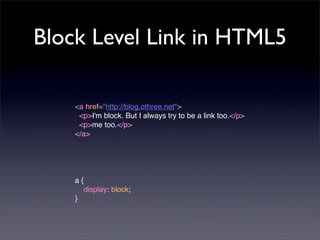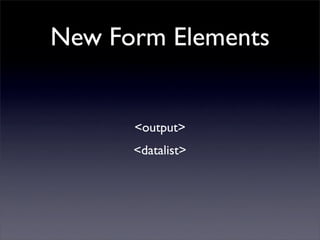TOSSUG HTML5 讀書會 新標籤與表單
- 1. HTML5 The Missing Part othree
- 2. Outline • Semantic Web • HTML5 • Web Forms 2.0
- 3. Semantic Web • Tim Bernes Lee
- 4. What is Semantic Web •
- 5. So •
- 7. How ? • XML for data • (X)HTML for web content
- 8. (X)HTML Standards • HTML 4.01: Still using today • XHTML 1: Bridge between HTML and XML • XHTML 1.1: Preparing for Semantic Web • XHTML 2.0 ( )
- 9. XHTML 2.0 • • • ex: no <h1> ~ <h6>, <br>
- 11. How ? • • <table> for not • <p> for • <h1> ~ <h6> for not • <blockquote> for not • <b>, <i>, <u>, <big>, <small>
- 13. 2nd Step • RDFa, Microformats ... etc
- 14. HTML <div> Bob Smith Smithy <a href="http://www.example.com">www.example.com</a>. Albuquerque (NM) ACME Corp. </div> http://www.google.com/support/webmasters/bin/topic.py?topic=21997
- 15. vCard BEGIN:VCARD VERSION:3.0 N:Bob Smith FN:Bob Smith NICKNAME:Smithy URL: http://www.example.com TITLE: ORG:ACME Corp ADR;TYPE=work:;;;Albuquerque;NM;; END:VCARD http://www.google.com/support/webmasters/bin/topic.py?topic=21997
- 16. RDFa <div xmlns:v="http://rdf.data-vocabulary.org/#" typeof="v:Person"> <span property="v:name">Bob Smith</span> <span property="v:nickname">Smithy</span> <a href="http://www.example.com" rel="v:url">www.example.com</a>. Albuquerque (NM) <span property="v:affiliation">ACME Corp</span>. <span property="v:title"> </span> </div> http://www.google.com/support/webmasters/bin/topic.py?topic=21997
- 17. Microformats <div class="vcard"> <span class="fn">Bob Smith</span> <span class="nickname">Smithy</span> <a href="http://www.example.com" class="url">www.example.com</a>. Albuquerque (NM) <span class="org">ACME Corp</span>. <span class="title"> </span> </div> http://www.google.com/support/webmasters/bin/topic.py?topic=21997
- 18. Microformats hCalendar hCard rel-license rel-nofollow rel-tag XFN XOXO ...
- 19. Benefits • (Accessibility) • SEO • •
- 20. HTML Standards • HTML 4.01: Still using today • XHTML 1: Bridge between HTML and XML • XHTML 1.1: Preparing for Semantic Web • XHTML 2.0 ( ) • (X)HTML5 by WHATWG
- 22. New Structure Elements <header> <footer> <nav> <aside> <article> <hgroup> <section>
- 23. A Web Page <div id=”header”></div> <ul id=”navigator”></ul> <div id=”sidebar”> <div id=”content”></div> </div> <div id=”footer”></div>
- 24. A Web Page in HTML5 <header></header> <nav></nav> <aside> <div id=”content”></div> </aside> <footer></footer>
- 25. Structure Elements • <header> • <footer> • <aside> • <nav>
- 26. Weblog Index <div class=”entry”></div> <div class=”entry”></div> <div class=”entry”></div>
- 27. Weblog Index <article></article> <article></article> <article></article>
- 29. An Article <h1></h1> <p></p> <h2></h2> <p></p> <h2></h2> <p></p>
- 30. An Article <h1></h1> <p></p> <section> <h2></h2> <p></p> <h2></h2> <p></p> </section>
- 31. <hgroup> <hgroup> <h1>My Weblog</h1> <h2 class="tagline">A lot of effort went into making this effortless.</h2> </hgroup> <div class="entry"> <h2>Travel day</h2> </div> <div class="entry"> <h2>I'm going to Prague!</h2> </div> http://diveintohtml5.org/semantics.html
- 32. Outline • My Weblog • Travel day • I'm going to Prague! http://diveintohtml5.org/semantics.html
- 33. Site Title and Article Title <h1>My Weblog</h1> <h2 class="tagline">A lot of effort went into making this effortless.</h2> <div class="entry"> <h2>Travel day</h2> </div> <div class="entry"> <h2>I'm going to Prague!</h2> </div> http://diveintohtml5.org/semantics.html
- 34. Outline • My Weblog • A lot of effort went into making this effortless • Travel day • I'm going to Prague! http://diveintohtml5.org/semantics.html
- 35. Mixin • Is <article> in <article> valid ? • Is <article> in <section> valid ? • How about <header> in <article> ?
- 36. Yes <article> <header> <h1>The Very First Rule of Life</h1> <p><time pubdate datetime="2009-10-09T14:28-08:00"></time></p> </header> <p>If there's a microphone anywhere near you, assume it's hot and sending whatever you're saying to the world. Seriously.</p> <p>...</p> <section> <h1>Comments</h1> <article> <footer> <p>Posted by: George Washington</p> <p><time pubdate datetime="2009-10-10T19:10-08:00"></time></p> </footer> <p>Yeah! Especially when talking about your lobbyist friends!</p> </article> </section> </article> http://dev.w3.org/html5/spec/sections.html#the-article-element
- 37. <article> <header> <h1>Title</h1> <p><time pubdate></p> </header> <p>Centent</p> <section> <h1>Comments</h1> <article> <footer> <p>Posted by</p> <p><time pubdate></p> </footer> <p></p> </article> </section> </article>
- 38. New Elements <figure> <figcaption>
- 40. Actually for • Everything • image • code • blockquote • video • ...etc
- 41. Examples <figure> <img src="bubbles-work.jpeg" alt="Bubbles, sitting in his office chair, works on his latest project intently."> <figcaption>Bubbles at work</figcaption> </figure> http://dev.w3.org/html5/spec/grouping-content.html#the-figure-element
- 42. Examples <figure> <p>'Twas brillig, and the slithy toves<br> Did gyre and gimble in the wabe;<br> All mimsy were the borogoves,<br> And the mome raths outgrabe.</p> <figcaption><cite>Jabberwocky</cite> (first verse). Lewis Carroll, 1832-98</figcaption> </figure> http://dev.w3.org/html5/spec/grouping-content.html#the-figure-element
- 45. New Inline Elements <b>, <i>, <small> <ruby>, <rt>, <rp> <mark> <time> <a>
- 46. b, i, small redefine • <b> for typographic presentation is boldened • <i> for alternate voice or mood • <small> for small print
- 49. Ruby Markup <ruby> <rt> </rt> <rt> </rt> </ruby> http://dev.w3.org/html5/spec/text-level-semantics.html#the-ruby-element
- 50. <rp> <ruby> <rp>(</rp><rt> </rt><rp>)</rp> <rp>(</rp><rt> </rt><rp>)</rp> </ruby> ( ) ( ) http://dev.w3.org/html5/spec/text-level-semantics.html#the-rp-element
- 51. <mark>
- 52. mark usage • • • highlight • ...etc
- 53. Example <p lang="en-US">Consider the following quote:</p> <blockquote lang="en-GB"> <p>Look around and you will find, no-one's really <mark>colour</mark> blind.</p> </blockquote> <p lang="en-US">As we can tell from the <em>spelling</em> of the word, the person writing this quote is clearly not American.</p> http://dev.w3.org/html5/spec/text-level-semantics.html#the-mark-element
- 54. <time>
- 55. Example <time datetime="2006-09-23">a Saturday</time> <time pubdate datetime="2009-08-30">today</time> http://dev.w3.org/html5/spec/text-level-semantics.html#the-time-element
- 56. Annoying pubdate • without pubdate : just a time • with pubdate : page publish time • with pubdate and inside an <article> : article’s publish time
- 57. <a> • block level link howto ? • XHTML 2 : • href is global level attribute • HTML5 ?
- 58. Block Level Link in HTML5 <a href="http://blog.othree.net"> <p>I'm block. But I always try to be a link too.</p> <p>me too.</p> </a> a{ display: block; }
- 60. Microdata
- 61. Remember Microformats ? <div class="vcard"> <span class="fn">Bob Smith</span> <span class="nickname">Smithy</span> <a href="http://www.example.com" class="url">www.example.com</a>. Albuquerque (NM) <span class="org">ACME Corp</span>. <span class="title"> </span> </div> http://www.google.com/support/webmasters/bin/topic.py?topic=21997
- 62. Microdata <div itemscope itemtype="http://data-vocabulary.org/Person"> <span itemprop="name">Bob Smith</span> <span itemprop="nickname">Smithy</span>. <a href="http://www.example.com" itemprop="url">www.example.com</a> Albuquerque (NM) <span itemprop="title"> </span> <span itemprop="affiliation">ACME Corp</span> </div> http://www.google.com/support/webmasters/bin/topic.py?topic=21997
- 63. attributes • itemscope : • itemtype : • itemprop :
- 64. APIs • document . getItems( [ types ] ) • element . properties • element . itemValue [ = value ] http://www.w3.org/TR/2010/WD-microdata-20100624/#microdata-dom-api
- 65. No Browser Supports Now
- 66. Web Forms 2.0
- 67. Where is 1.0 ?
- 68. HTML 4.01 Spec http://www.w3.org/TR/html401/
- 69. What’s New • New Input Types • New Attributes • Form Validation
- 70. New Input Types url email tel number range color date
- 71. <input type="datetime" /> <input type="number" min="99" max="101"/> <input type="email" placeholder="[email protected]" />
- 73. And One More Type search
- 74. New Form Elements <output> <datalist>
- 75. <output> <form> <input name=a type=number step=any> + <input name=b type=number step=any> = <output onforminput="value = a.valueAsNumber + b.valueAsNumber"></output> </form> http://dev.w3.org/html5/spec/the-button-element.html#the-output-element
- 76. <datalist> <input type="search" autofocus list="search-suggestions"/> <datalist id="search-suggestions"> <option label="DM" value="Depeche Mode"> <option label="Moz" value="Morrissey"> <option label="NO" value="New Order"> <option label="TC" value="The Cure"> </datalist> http://miketaylr.com/pres/html5/forms2.html
- 77. New Attributes • autofocus: auto focus • autocomplete: browser’s auto complete • placeholder: short hint • multiple for [type=file]: upload multiple file
- 78. Validation • support new input types • pattern attribute for <input> • novalidate attribute for <form>
- 81. Q&A
































































![APIs
• document . getItems( [ types ] )
• element . properties
• element . itemValue [ = value ]
http://www.w3.org/TR/2010/WD-microdata-20100624/#microdata-dom-api](https://image.slidesharecdn.com/tossughtml5-100720105527-phpapp02/85/TOSSUG-HTML5-64-320.jpg)












![New Attributes
• autofocus: auto focus
• autocomplete: browser’s auto complete
• placeholder: short hint
• multiple for [type=file]: upload multiple file](https://image.slidesharecdn.com/tossughtml5-100720105527-phpapp02/85/TOSSUG-HTML5-77-320.jpg)









































![[系列活動] Machine Learning 機器學習課程](https://cdn.slidesharecdn.com/ss_thumbnails/ml4ds02122017-170212005829-thumbnail.jpg?width=560&fit=bounds)





![HTML5: Smart Markup for Smarter Websites [Future of Web Apps, Las Vegas 2011]](https://cdn.slidesharecdn.com/ss_thumbnails/html5smartmarkupforsmarterwebsites-futureofwebappslasvegas2011-110628193453-phpapp01-thumbnail.jpg?width=560&fit=bounds)














































